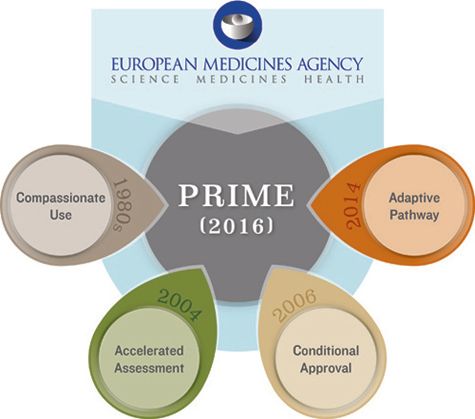'PRIME' Time for Medicines in the EU
Pharmaceutical Executive
A look at how Europe's new accelerated drug approval scheme can evolve existing review pathways for the better-and take a page from FDA
The European Medicines Agency (EMA) has launched an innovative new scheme to enable “PRIority MEdicines (PRIME)” to be developed quickly within Europe by facilitating closer collaboration between EMA expert committees and sponsor companies. PRIME is an advancement in European regulation of medicines. This program will bring the European Union (EU) closer to the FDA by facilitating early patient access to innovative medicines. PRIME, coupled with the new Clinical Trials Regulation, means Europe will secure its position as a key player for innovative medicines research. This article highlights several accelerated review pathways in the EU and US and discusses how they have evolved to benefit patients.
EU accelerated pathways
A key factor for entry into PRIME is a company’s ability to demonstrate that its investigational treatment will improve a patient’s quality of life based on early clinical development data. The scheme consolidates the existing pathways for accelerated review of medicinal products in Europe, which include: accelerated assessment, conditional and exceptional marketing authorization, compassionate use programs, and the adaptive pathway to faster access.
The European accelerated assessment of medicines reduces the review time within the centralized procedure for medicines designated by EMA to be of major public interest or a therapeutic innovation. Under the existing accelerated assessment pathway in Europe, companies approach the EMA at least six months before their marketing authorization application (MAA) is submitted to hold a pre-submission meeting to discuss their application strategy and again two to three months before their application is submitted. This initiative has not been enough on its own to drive access to medicines for patients with an unmet medical need, and very few products have successfully used this route in Europe, which may be due to its complexity and the regulatory expertise required to navigate the process.
The conditional marketing authorization pathway in Europe is for products that treat, prevent, or diagnose seriously debilitating or life-threatening diseases; or are used in emergency situations; or for orphan products. In this process the applicant must demonstrate a favorable benefit-risk ratio and will commit to provide additional data to EMA on a yearly basis. A sponsor is able to discuss the possibility for conditional approval with EMA early on in the product’s development via scientific advice or protocol assistance. The Committee for

Medicinal Products for Human Use (CHMP) can suggest a sponsor adopt this approval route if they feel it is justified. The sponsor will eventually provide all the data required for a full dossier post-approval, which differs from an exceptional circumstances MAA that is reviewed annually and does not require a full dossier of data. Conditional authorization has not been used by many companies as a route to market.
The EMA also presides over compassionate use programs (CUPs) in the EU for sponsors to make products available without an authorization for patients who have no other form of treatment and who cannot enter clinical trials. CUPs are governed by different member states in Europe, which separately may ask EMA to provide an opinion on how to establish a CUP for a product on a national basis. There are currently only five ongoing CUPs within Europe that have sought an EMA opinion; however, there are more in operation nationally. CUPs are not well publicized and may not be available to all patients who could benefit from them.
The EMA has an adaptive pathway pilot program in operation, which predates PRIME. The program was developed from the ADAPT SMART consortium in Europe to promote innovation and access to medicines. This group established the adaptive pathway as a pilot to allow companies to seek approval for medicines earlier in the development of their data package. This pathway allows companies to gain conditional approval and then gather data on a rolling basis starting with smaller patient populations, then expanding to

more patient groups. Data are collated from real-life use of products to add to clinical trial data, and patient groups and health technology assessment (HTA) bodies are involved in an early dialogue to review the development of products. The EMA has received 34 applications for the adaptive pathway and 10 were accepted, highlighting the popularity of the program since 2014.
Prior to the introduction of PRIME, only a few companies succeeded in accessing the fast-track assessment pathways in Europe. Since 2006, only 22 medicines have been reviewed via the accelerated assessment route and 28 products have received a conditional MAA. This is in contrast to the FDA accelerated assessment pathways, where 110 applicants were accepted into the FDA breakthrough therapy program since 2012 and 30 have been approved.
US accelerated assessment pathways
The FDA accelerated assessment pathways are fast track, breakthrough therapy, accelerated approval, and priority review. Fast-track review is for medicines that target an unmet medical need with a new therapy or improve existing treatments. In this review, there is increased access to FDA experts to discuss development plans and progress, and there is a rolling review of data for new drug applications (NDAs) or biologics license applications (BLAs). Successful applicants in the fast-track path may qualify for accelerated approval or priority review. Breakthrough therapy is for medicines that show a substantial benefit to patients over and above existing treatments for a clinically significant endpoint (e.g., irreversible morbidity or mortality) based on clinical data already generated for the product (as early as Phase I and not later than Phase II). This program offers applicants the chance to speak to senior managers at the FDA and, if successful, they may enter the fast-track pathway. Breakthrough designation is very similar to PRIME and has positively influenced European regulators.
Accelerated approval in the US has been in place since the 1990s, but in 2012-two years prior to the EMA adaptive pathway-Congress solidified the FDA approach by approving the use of surrogate endpoints as a basis for product approval. The FDA requires Phase IV confirmatory trials for medicines approved via surrogate or intermediate clinical endpoints and can alter the approval of medicines based on Phase IV data. This process permits medicines that show a significant benefit to be given to patients quickly. Priority review in the US is the culmination of the US expedited pathways. The FDA commits to review an NDA or BLA in six months, not the standard 10-month timeframe, if the product demonstrates a benefit to patients.
Innovation done quick(er)
Successful products in PRIME will receive support earlier in development, and the EMA will provide access to its expert committees and HTA bodies, which will improve the long term commercial prospects of PRIME medicines. PRIME provides an exciting development pathway in Europe to companies that struggle with the complex regulatory hurdles and development costs of bringing new treatments to market. The mechanism also heavily supports academia and small-to- medium-sized companies that can apply based on non-clinical and tolerability data at an even earlier stage of development. This supports all sectors within the biopharmaceutical industry, fostering faster and better access to innovative medicines within the EU.
Anusha Bala is Global Head of Regulatory Affairs at Novella Clinical. She can be reached at abala@novellaclinical.com

Navigating Distrust: Pharma in the Age of Social Media
February 18th 2025Ian Baer, Founder and CEO of Sooth, discusses how the growing distrust in social media will impact industry marketing strategies and the relationships between pharmaceutical companies and the patients they aim to serve. He also explains dark social, how to combat misinformation, closing the trust gap, and more.